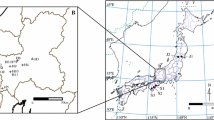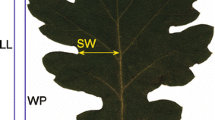Abstract
The detection of hybridity inLeucaena is discussed in relation to: (i) traditional criteria, (ii) molecular criteria and (iii) models to predict hybrid leaf morphology. Morphological, geographical and molecular evidence for the occurrence of interspecific hybrids betweenL. leucocephala andL. diversifolia in south-central Mexico, northern Guatemala, Jamaica, Dominican Republic, the Philippines and Papua New Guinea is presented. Predicted mean hybrid leaf trait values calculated from parent material are compared with data from putative hybrids and shown to be similar. The origin of these hybrids is discussed and shown to be the result of artificial sympatry resulting from indigenous, and recent exotic, domestication of the parent species. The hybrid is described asL. ×spontanea.
Similar content being viewed by others
References
Adams, R. P., 1982: A comparison of multivariate methods for the detection of hybridization. — Taxon31: 646–661.
Alston, R. E., Turner, B. L., 1963: Natural hybridization among four species ofBaptisia (Leguminosae). — Amer. J. Bot.50: 159–173.
Anderson, E., 1949: Introgressive hybridization. — New York: Wiley.
Avise, J. C., 1994: Molecular markers, natural history and evolution. — New York, London: Chapman & Hall.
, 1984: Hybridisation and introgression among species of sunfish (Lepomis): Analysis by mitochondrial DNA and allozyme markers. — Genetics108: 237–255.
Baum, B. R., 1969: On the application of nomenclature to the taxonomy of hybrids. — Taxon18: 670–671.
Black, W. C., 1993: PCR with arbitrary primers: approach with care. — Insect Molec. Biol.2: 1–6.
Brewbaker, J. L., 1987:Leucaena: a multipurpose tree genus for tropical agroforestry. — InSteppler, H. A., Nair, P. K., (Eds): Agroforestry: a decade of development, pp. 289–322. — Nairobi, Kenya: International Council for Research on Agroforestry.
, 1990:Leucaena: new tree crops from interspecificLeucaena hybrids. — InJanick, J., Simon, J., (Eds): Advances in new crops, pp. 283–289. — Oregon, USA: Timber Press.
, 1994: Domestication of lesser-known species ofLeucaena. — InLeakey, R. R. B., Newton, A. C., (Eds): Tropical trees: the potential for domestication and rebuilding of forest resources, pp. 195–204. — London: HMSO.
, 1988: Psyllid tolerant highlandLeucaena yields. —Leucaena Res. Rep.9: 11–13.
Casas, A., Caballero, J., 1996: Traditional management and morphological variation inLeucaena esculenta (Moç. & Sessé ex A. DC.)Benth. (Fabaceae:Mimosoideae) in the Mixtec region of Guerrero, Mexico. — Econ. Bot.50: 167–181.
Correll, D. S., Johnston, M. C., 1970: Manual of vascular plants of Texas, pp. 774–775. — Remer: Texas Research Foundation.
Crawford, D. J., Brauner, S., Cosner, M. B., Stuessy, T. F., 1993: Use of RAPD markers to document the origin of the intergeneric hybrid ×Margyracaena skottsbergii (Rosaceae) on the Juan Fernandez Islands. — Amer. J. Bot.80: 89–92.
Dawson, I. K., Simons, A. J., Waugh, R., Powell, W., 1996: Detection and pattern of interspecific hybridization betweenGliricidia sepium andG. maculata in Meso-America revealed by PCR-based assays. — Molec. Ecol.5: 89–98.
De Freitas, L. H. C., Whitmann, M. T. S., Paim, N. R., 1991: Floral characteristics, chromosome number and meiotic behaviour of hybrids betweenLeucaena leucocephala (2n=104) and tetraploidL. diversifolia (2n=104) (Leguminosae). — Revista Brasil. Genét.14: 781–789.
Dijkman, M. J., 1950:Leucaena — a promising soil erosion control plant. — Econ. Bot.4: 337–349.
Doyle, J. J., Brown, A. H. D., 1989: 5s nuclear ribosomal gene variation in theGlycine tomentella polyploid complex. — Syst. Bot.14: 398–407.
, 1984: Evolution of rDNAs inClaytonia polyploid complexes. — InGrant, W. F., (Ed.): Plant biosystematics, pp. 321–341. — London: Academic Press.
Filer, D. L., 1996: BRAHMS: Botanical research and herbarium management system. — Reference manual version 4.1, September 1996. — Oxford: University of Oxford.
Frahm-Leliveld, J. A., 1957: Observations cytologiques sur quelques Legumineuses tropicales et subtropicales. — Rev. Cytol. Biol. Vég.8: 273–287.
Gonzalez, V., Brewbaker, J. L., Hamill, D. E., 1967:Leucaena cytogenetics in relation to the breeding of low mimosine lines. — Crop Sci.7: 140–143.
Gottlieb, L. D., 1972: Levels of confidence in the analysis of hybridization in plants. — Ann. Missouri Bot. Gard.59: 435–446.
, 1977: Electrophoretic evidence and plant systematics. — Ann. Missouri Bot. Gard.64: 161–180.
Greuter, W., Barrie, F. R., Burdet, H. M., Chaloner, W. G., Demoulin, V., Hawksworth, D. L., Jorgensen, P. M., Nicholson, D. H., Silva, P. C., Trehane, P., (Eds), 1994: International code of botanical nomenclature. — Regnum Veg.131. — Germany: Koeltz.
Harris, S. A., 1995: Systematics and randomly amplified polymorphic DNA in the genusLeucaena (Leguminosae, Mimosoideae). — Pl. Syst. Evol.197: 195–208.
, 1994: A phylogenetic analysis ofLeucaena (Leguminosae:Mimosoideae). — Pl. Syst. Evol.191: 1–26.
Hawkins, J. A., Harris, S. A., 1998: RAPD characterisation of two Neotropical hybrid legumes. — Pl. Syst. Evol. (in press).
Hawthorne, W. D., 1996: Multiscale information and cartographic assistant, MUSICA. Version 1.0 — Oxford: University of Oxford.
Hillis, D. M., Moritz, C., Mable, B. K., 1996: Molecular systematics. — Sunderland, Mass.: Sinauer.
Holmgren, P. K., Holmgren, N. H., Barnett, L. C., 1990: Index herbariorum. Part 1: The herbaria of the world. 8th edn. — New York: New York Botanical Garden.
Hughes, C. E., 1998: Monograph ofLeucaena Benth. (Leguminosae:Mimosoideae). — Syst. Bot. Monogr.55 (in press).
, 1994: The characterisation and identification of a naturally occurring hybrid inLeucaena Benth. (Leguminosae:Mimosoideae). — Pl. Syst. Evol.192: 177–197.
, 1995: Systematics ofLeucaena: recent findings and implications for breeding and conservation. — InShelton, H. M., Piggin, C. M., Brewbaker, J. L., (Eds):Leucaena — opportunities and limitations. Proceedings of a Workshop held in Bogor, Indonesia, January 1994, pp. 54–65. — ACIAR Proceedings57. — Canberra: Australian Centre for International Agricultural Research.
Humphries, C. J., 1983: Primary data in hybrid analysis. — InPlatnick, N. I., Funk, V. I., (Eds): Proceedings of the second meeting of the Willi Hennig Society. — Advances in Cladistics2, pp. 90–103. — New York: Columbia University Press.
Hutton, E. M., 1981: Natural crossing and acid tolerance in someLeucaena species. —Leucaena Res. Rep.2: 2–4.
Irwin, J. A., Abbott, R. J., 1992: Morphometric and isozyme evidence for the hybrid origin of a new tetraploid radiate groundsel in York, England. — Heredity69: 431–439.
Jarne, P., Lagode, P. J. L., 1996: Microsatellites, from molecules to populations and back. — Trends Ecol. Evol.11: 424–429.
Manly, B. F. J., 1986: Multivariate statistical methods. A primer. — London: Chapman & Hall.
McDade, L. A., 1990: Hybrids and phylogenetic systematics. I. Patterns of character expression in hybrids and their implications for cladistic analysis. — Evolution44: 1685–1700.
, 1992: Hybrids and phylogenetic systematicsII. The impact of hybrids on cladistic analysis. — Evolution46: 1329–1346.
, 1995: Hybridization and phylogenetics. — InHoch, P. C., Stephenson, A. G., (Eds): Experimental and molecular approaches to plant biosystematics, pp. 305–331. — St. Louis: Missouri Botanical Garden.
Moffet, A. A., Nixon, K., 1958: Genetical studies in Acacias II. Leaf characters in hybrids between black and green wattles. — Heredity12: 199–218.
National Academy of Sciences, 1984:Leucaena: promising forage and tree crop for the tropics. — Washington DC, USA: National Academy of Sciences.
Newbury, H. J., Ford-Lloyd, B. V., 1993: The use of RAPD for assessing variation in plants. — Pl. Growth Regulation12: 43–51.
Nielsen, I., 1992:Leucaena. Mimosaceae (Leguminosae:Mimosoideae). — Fl. Malesiana1, II: 182–183.
Pan, F. J., 1985: Systematics and genetics of theLeucaena diversifolia (Schltdl.)Benth. complex. — Unpubl. Ph. D. Thesis, University of Hawaii, Honolulu.
, 1988: Comparison of diploid and tetraploidLeucaena diversifolia. — Quart. J. Chin. Forest.21: 89–98.
, 1988: Cytological studies in the genusLeucaena Benth. — Cytologia (Tokyo)53: 393–399.
Pound, B., Martinez-Cairo, L., 1983:Leucaena: its cultivation and use. — London: Overseas Development Administration.
Rieseberg, L. H., 1995: The role of hybridization in evolution: old wine in new skins. — Amer. J. Bot.82: 944–953.
, 1996: Homology among RAPD fragments in interspecific comparisons. — Molec. Ecol.5: 99–105.
, 1992: Molecular evidence and plant introgression. — InSoltis, P. S., Soltis, D. E., Doyle, J. J., (Eds): Molecular systematics of plants, pp. 151–176. — London: Chapman & Hall.
, 1993: What can molecular and morphological markers tell us about hybridization? — Crit. Rev. Pl. Sci.12: 213–241.
, 1993: Genomic map of diploid hybrid species. — Heredity70: 285–293.
, 1995: Hybrid speciation accompanied by genomic reorganization in wild sunflowers. — Nature375: 313–316.
Rosen, D. E., 1979: Fishes from the uplands and intermontane basins of Guatemala. Revisionary studies and comparative biogeography. — Bull. Amer. Mus. Nat. Hist.162: 267–376.
Shibata, K., 1962: Estudios citológicos de plantas colombianos silvestres y cultivadas. — J. Agric. Sci.8: 49–62.
Skala, Z., Zrzavy, J., 1994: Phylogenetic reticulations and cladistics: discussion of methodological concepts. — Cladistics10: 305–313.
Smith, J. J., Scott-Craig, J. S., Leadbetter, J. R., Bush, G. L., Roberts, D. L., Fulbright, D. W., 1994: Characterization of random amplified polymorphic DNA (RAPD) product fromXanthomonas campestris and some comments on the use of RAPD products in phylogenetic analysis. — Molec. Phylogenet. Evol.3: 135–145.
Soltis, P. S., Soltis, D. E., 1991: Multiple origin of the allotetraploidTragopogon minus (Compositae): rDNA evidence. — Syst. Bot.16: 407–413.
Sorensson, C. T., 1989: Status and mechanisms of self-incompatibility and self-compatibility inLeucaena species. — Pl. Cell Incompat. Newsletter21: 77–85.
, 1993: Production and characterization of interspecific hybrids of the tropical tree genusLeucaena (Leguminosae:Mimosoideae). — Unpubl. Ph. D. Thesis, University of Hawaii, Honolulu.
, 1995: Potential for improvement ofLeucaena through interspecific hybridization. — InShelton, H. M., Piggin, C. M., Brewbaker, J. L., (Eds):Leucaena — opportunities and limitations. Proceedings of a workshop held in Bogor, Indonesia, January 1994, pp. 47–53. — ACIAR Proceedings57. — Canberra: Australian Centre for International Agricultural Research.
, 1994: Interspecific incompatibility among fifteenLeucaena species (Mimosoideae) via artificial hybridization. — Amer. J. Bot.81: 240–247.
Stace, C. A., 1975: Hybridization and the flora of the British Isles. — London: Academic Press.
, 1989: Plant taxonomy and biosystematics. — London: Arnold.
Taberlet, P., Gielly, L., Pautou, G., Bouvet, J., 1991: Universal primers for amplification of three non-coding regions of chloroplast DNA. — Pl. Molec. Biol.17: 1105–1109.
Tjio, J. H., 1948: The somatic chromosomes of some tropical plants. — Hereditas34: 135–146.
Timyan, J., 1996: Bwa yo: important trees of Haiti. — Washington: South-East Consortium for International Development.
Vos, P., Hogers, R., Bleeker, M., Reijans, M., Van de Lee, T., Hornes, M., Frijters, A., Pot, I., Pelemen, J., Kuiper, M., Zabeau, M., 1995: A new technique for DNA fingerprinting. — Nucl. Acids Res.23: 4407–4414.
Wagner, W. H., 1969: The role and taxonomic treatment of hybrids. — Bioscience19: 785–789.
, 1983: Reticulistics: the recognition of hybrids and their role in cladistics and classification. — InPlatnick, N., Funk, V., (Eds): Proceedings of the Second Meeting of the Willi Hennig Society. Advances in Cladistics,2, pp. 63–79. — New York: Columbia University Press.
Wang, W. Y., Pai, R. C., Lai, C. C., Lin, T. P., 1994: Molecular evidence for the hybrid origin ofPaulownia taiwaniana based on RAPD markers and RFLP of chloroplast DNA. — Theor. Appl. Genet.89: 271–275.
Wells, H., 1980: A distance coefficient as a hybridization index: an example usingMimulus longifolius andM. flemingii (Scrophulariaceae) from Santa Cruz Island, California. — Taxon29: 53–65.
Whitaker, T. W., Cutler, H. C., 1966: Food plants in a Mexican market. — Econ. Bot.20: 6–16.
White, T. J., Bruns, T., Lee, S., Taylor, J., 1990: Amplification and direct sequencing of fungal ribosomal RNA genes for phylogenetics. — InInnis, M., Gelfand, D., Sninsky, J., White, T., (Eds): PCR protocols: A guide to methods and applications, pp. 315–322. — San Diego: Academic Press.
Wilson, P., 1992: On inferring hybridity from morphological intermediacy. — Taxon41: 11–23.
Zárate, S. P., 1982: Las especies deLeucaena Benth. de Oaxaca con notas sobre la sistemática del género para México. — Unpubl. M. Sc. Thesis, Universidad Autonóma de México, Mexico City.
, 1984: Taxonomic revision of the genusLeucaena Benth. from Mexico. — Bull. Groupe Int. ÉtudeMimosoideae 12: 24–34.
, 1987: Taxonomic identity ofLeucaena leucocephala (Lam.)De Wit with a new combination. — Phytologia63: 304–306.
, 1994: Revisión del géneroLeucaena Benth. en México. — Ann. Inst. Biol. Univ. Nac. Auton. México, Ser. Bot.65: 83–162.
Zimmer, E. A., Jupe, E. R., Walbot, V., 1988: Ribosomal gene structure, variation and inheritance in maize and its ancestors. — Genetics120: 1125–1136.
Author information
Authors and Affiliations
Rights and permissions
About this article
Cite this article
Hughes, C.E., Harris, S.A. A second spontaneous hybrid in the genusLeucaena (Leguminosae, Mimosoideae). Pl Syst Evol 212, 53–77 (1998). https://doi.org/10.1007/BF00985221
Received:
Revised:
Accepted:
Issue Date:
DOI: https://doi.org/10.1007/BF00985221




